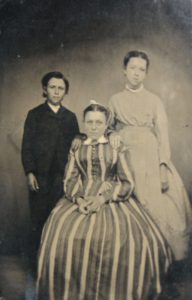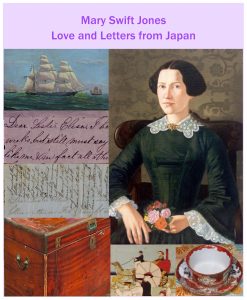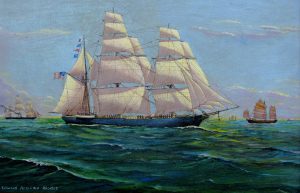By Beverly C. Tyler
“I manage to go on shore more or less in every port and learn the different manners and customs of different nations and the works of God and man, both nature and art. I find much to amuse, edify and interest us, and see what so many travelers pay large sums for, while Henry makes a living and the brig is our hotel and even what is much better, our home.” — Mary Rowland, January 1873
In the graveyard of Setauket Presbyterian Church, near the center rear, lie the graves of Captain Henry L. Rowland (1827-1876) and his wife, Mary Satterly Rowland (1832-1908). The couple’s farm was situated south of their final resting place, between Main Street and Setauket Harbor. Today, Setauket School faces what was once the Rowland farm.

Mary is one of the women featured in the Three Village Historical Society’s Spirits cemetery tour. Her life, like that of many women who lived in the area and traveled the world, remains largely unknown. A portion of Mary’s tumultueous sea adventures is documented in the book “Hen Frigates” by New Zealander Joan Druett.
“At 4 a.m., tacking on shore,” Mary Rowland wrote in 1856, “the vessel was rolling and pitching badly.” Everything below was “upside down, and there is no rest or peace to be had. Worst of all, one could hardly keep in bed, especially on one tack; when I sit down, I must of necessity take the floor for a sofa.”
Despite the hardships, Henry and Mary spent over 20 years living aboard three different sailing ships that traveled the world, carrying cargo from port to port. The couple’s children grew up on these ships, built in East Setauket, and one of them, Woodhull, was born on board.
“The captain’s wife gave birth to a child,” reads the logbook entry of the brig Thomas W. Rowland for October 21, 1857, near the island of Abaco. Mary Rowland’s two daughters, Henrietta and Mary Emma, were sent between decks with their dolls to play while Henry delivered the baby boy, christened Woodhull.
During the American Civil War, Captain Henry Rowland’s bark Glenwood sailed under sealed orders, with its destination (Pensacola, to deliver supplies to the troops) unknown until the orders were opened. The voyage south was traumatic; the vessel was struck twice by lightning, resulting in the death of one crew member. Mary’s youngest child, Willie, fell ill with yellow fever as they neared Pensacola Bay. All night, as they lay hove to near Santa Rosa Island, she fought for her son’s life while cannonballs from Confederate and Union gunships screamed overhead. When the battle was over, the Glenwood had survived unscathed but the little boy was dead.

The diaries, journals, letters and artifacts of Setauket wives Mary Satterly Rowland, Mary Swift Jones and Ellen Elizabeth Jones, along with the logbooks of their captain husbands, are part of the collection at the Three Village Historical Society. These materials, donated by local residents and relatives, provide valuable insight into the lives of women at sea aboard wooden commercial ships. These women, along with their children in many cases, traveled the world with their husbands and fathers. Their experiences are part of the many stories told in the Society’s exhibition, “The Sailing Circle: 19th Century Seafaring Women from New York.”
The two Marys are featured in Hen Frigates along with many other women and children whose adventures make for fascinating reading. They are also included in the exhibit catalog The Sailing Circle, available in the society gift shop.
“Hen Frigates” by Joan Druett, available at the Emma S. Clark Library, is a seafaring book packed with intriguing details about shipboard life during the 19th century, when wooden ships and their crews journeyed along the North American coast and around the world. More than just a book about families at sea, Hen Frigates covers in dramatic detail the growth of American maritime commerce in the 19th century.
One of the most interesting aspects of local history is its connections to larger realms of people and events. Our community is linked in many ways to our region, nation and the world—a reality that has persisted throughout our history. The Three Village community is wonderfully rich in both natural and man-made resources that illustrate and exemplify these connections.
Beverly Tyler is an author and the historian for the Three Village Historical Society, located at 93 North Country Road, Setauket. Visit www.tvhs.org for more information.








